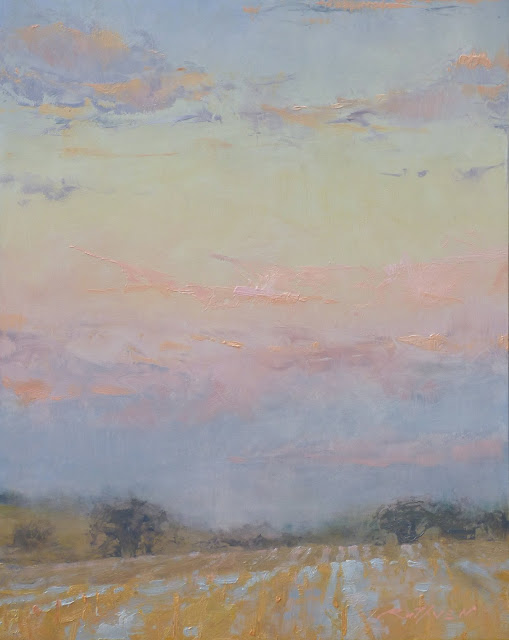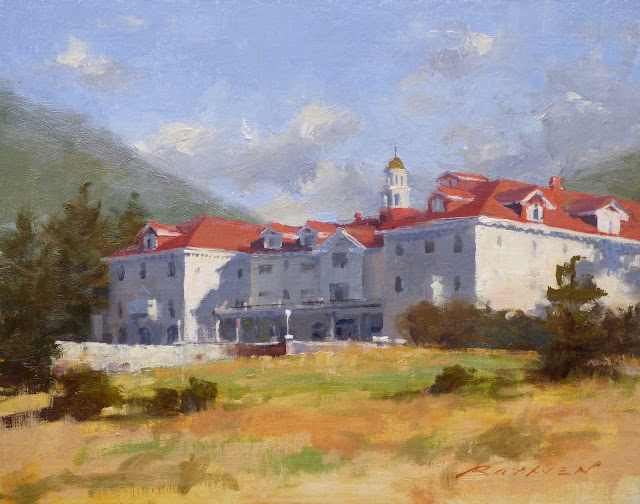In this third and final post, I'll show you how to make the panel holder which secures your painting surface to your tripod.
 |
| The wooden contraption holding my painting is the panel holder |
Material list:
- (1) 1"x2"x4' piece of oak or similar hard wood.
- (1) 1/4"-20x5/16" T-Nut.
- (1) 1/4" x 1.25" long carriage bolt.
- (1) 1/4" female thumb screw head.
- (1) Metal washer to fit around the 1/4" bolt.
- (2) Small 3/4" nails and some wood glue (to attach the bottom ledge to the main body).
I bought all the parts at my local Home Depot but you can find the wood at most lumber yards and the hardware at ACE hardware or other hardware stores.
Required tools:
- Fine toothed hand saw
- Table saw
- Drill
- 3/4" spade drill bit
- 3/8" regular drill bit
- 1/4" regular drill bit
- Hammer
The main component of my holder is the 1"x2", 4' long piece of oak. The actual size is .5"x1.5"x4'. I chose oak because it is a rigid hard wood that will stand up to some abuse but you can use whatever you want.
Process:
1. Cut this 4' piece of oak into the following lengths:
- (1) 24" piece for the main body
- (1) 4" piece for the bottom ledge
- (1) 6" piece for the top support
2. With your table saw, plunge cut a slot lengthwise down the center of the 24" piece. The slot must be a little wider than 1/4" so the bolt you will run through it can move along the length easily.
This is a tricky and dangerous cut to make and you should not attempt it if you are not trained and familiar with this type of cut on a table saw. The slot should start about 3" down from the top and end 3.5" up from the bottom of the 24" main body piece.
3. With a 3/4" spade drill bit, drill a hole
halfway through the main body piece, 2" up from the bottom. Center this hole on the 1.5" width of the board. Then, switch to a 3/8" standard drill bit and drill a hole in the center if this 3/4" hole that goes the rest of the way through the board. This is where you will mount the T-Nut in the next step.
4. Insert the 1/4" T-Nut into the hole you just drilled. The T-Nut has four spines that you want to drive into the wood so it will not turn when you attach the tripod mount to it. You can set the T-Nut in place by hammering it down with a small block of wood or dowel. It should be recessed into the 3/4" hole you drilled.
5. Angle your table saw blade to cut a 15 degree bevel along one long edge of the 4" and 6" pieces. This bevel will help hold on to your painting panel.
6. Attach the 4" bottom ledge piece perpendicular to the 24" main body piece with the bevel edge facing up (see picture). Attach it to the bottom end of the 24" piece, just below the T-Nut. I put some glue on it and then nailed it to the 24" piece. You want to make sure this 4" piece is at a 90 degree angle to the 24" piece. This 4" piece is what supports the bottom of your painting panel.
7. Drill a 1/4" hole all the way through the 6" top support piece...centering the hole 3" from either end.
8. Coat all the wood pieces with polyurethane. This will protect the wood, waterproof it and make it easier to clean.
9. To attach the top support piece to the main body, insert the 1/4" carriage bolt through the slot on the 24" board from the back then through the hole you drilled in the 4" top support piece. The bolt should protrude 1/4". Place the washer over the end of the bolt sticking out and then screw on the thumb screw head. You can now adjust this top support up and down the main body and use the thumb screw to tighten it down.
10. Screw on the tripod mounting bracket that came with your tripod to the T-Nut from the backside of the panel holder.
11. Attach the holder to your tripod.
12. Now you can secure a painting panel to the holder by adjusting the top support to accommodate whatever panel size you are using.
 |
| Here's a closeup of the bottom end of the holder. |
 |
| 1/4"-20x5/16" T-Nut |
 |
| The top support assembly |
 |
| My camera to tripod mounting bracket attached to the T-Nut on the backside of the panel holder. |
So, now that you know how to make one, unless you love woodworking, save yourself the hassle and buy the whole setup from James Coulter at
http://artboxandpanel.com/. I don't know James and get no profit from this but I'm telling you, you can get the palette and panel carrier and even a tripod from him for a great price and he makes a great product.
Now get out there and paint!












